Typhoon-Resistant Housing: Container Worker Dormitories Feature Lida Group’s Reinforced Prefab Building Structures for Coastal Projects
2025-Aug-22 11:59:49
By Admin
1. Introduction
Coastal regions around the world are vital hubs for industrial activity, hosting major construction projects, port developments, offshore energy installations, and fisheries. However, these areas are also highly vulnerable to typhoons—powerful tropical cyclones with sustained winds exceeding 119 km/h (74 mph) that bring destructive storm surges, heavy rainfall, and widespread damage. For workers living in temporary accommodation near these coastal projects, typhoons pose significant risks to safety, with traditional housing solutions often failing to withstand such extreme conditions.
Lida Group, a leader in prefabricated building solutions, has developed specialized container worker dormitories designed to resist typhoons. These structures incorporate reinforced prefab building technologies that enable them to withstand high winds, storm surges, and heavy rain, providing safe and secure housing for workers in coastal areas. This article explores how Lida Group’s typhoon-resistant container dormitories address the unique challenges of coastal environments, from their structural design and engineering to real-world performance and future innovations.
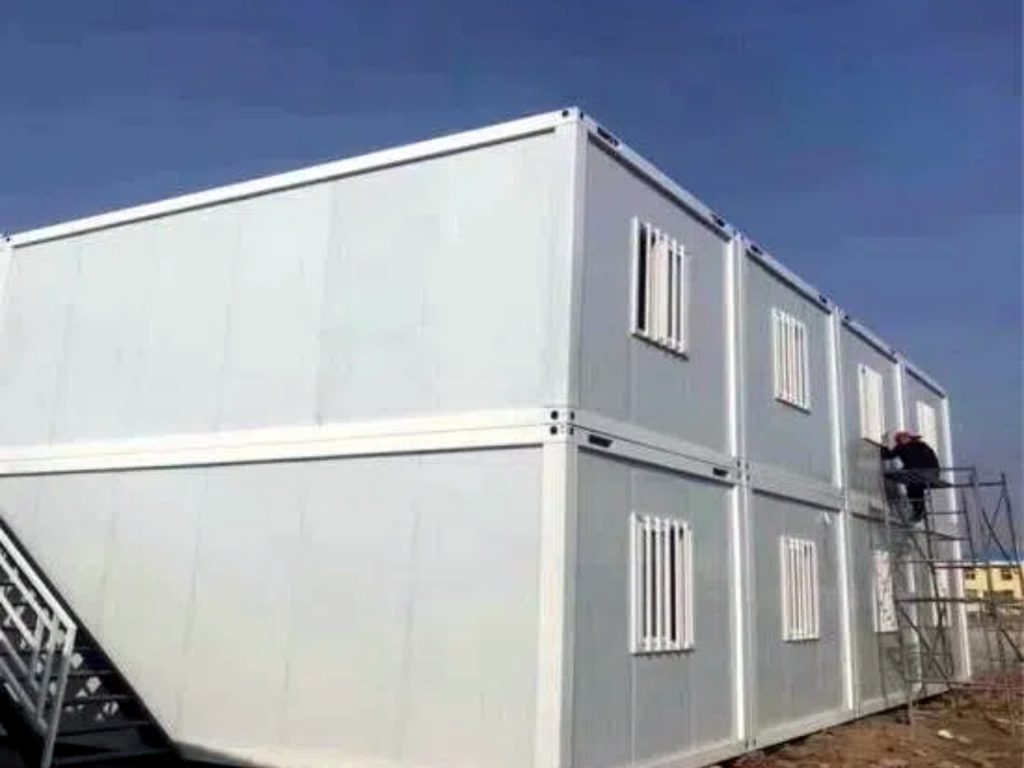
2. The Risks of Typhoons to Coastal Worker Accommodation
2.1. Wind Damage
Typhoon-force winds can easily destroy traditional temporary housing, such as tents, wooden cabins, or poorly constructed concrete structures. High winds exert extreme pressure on walls and roofs, causing them to collapse or be torn away. Flying debris—including loose materials, tools, or even parts of damaged buildings—becomes dangerous projectiles, further endangering workers and damaging property.
In coastal construction zones, where worker dormitories are often located in open areas with little natural protection, the risk of wind damage is amplified. A single typhoon can render accommodation uninhabitable, halting project progress and leaving workers homeless.
2.2. Storm Surges and Flooding
Storm surges—abnormal rises in sea level caused by typhoons—are among the most deadly and destructive aspects of these storms. Surges can reach heights of 10 meters or more, flooding coastal areas and submerging low-lying housing. Even moderate flooding can damage electrical systems, contaminate water supplies, and weaken building foundations, making accommodation unsafe long after the storm passes.
Heavy rainfall accompanying typhoons exacerbates flooding, overwhelming drainage systems and increasing the risk of landslides in hilly coastal regions. Traditional worker dormitories, often built with minimal elevation or waterproofing, are particularly susceptible to water damage.
2.3. Operational Disruptions
Beyond safety risks, typhoon damage to worker accommodation leads to significant operational disruptions. Projects may be delayed for weeks or months while housing is repaired or rebuilt, resulting in financial losses, missed deadlines, and reputational damage. In regions prone to frequent typhoons—such as Southeast Asia, the Pacific Islands, and parts of the Americas—these disruptions can become a recurring challenge, undermining project efficiency and profitability.
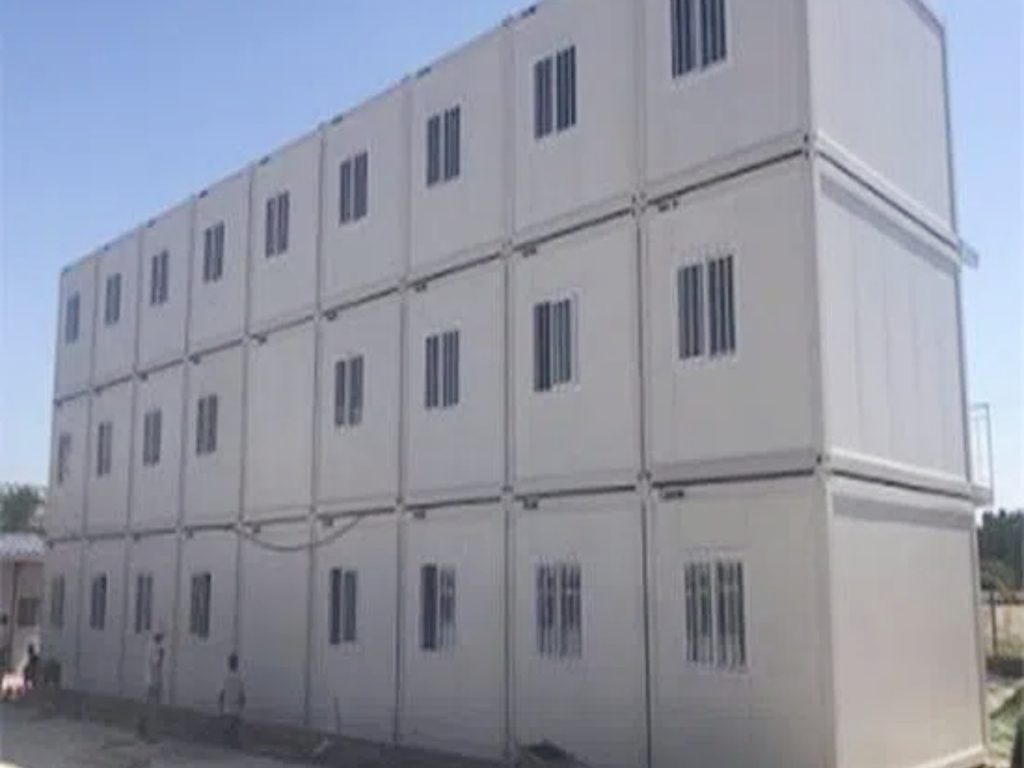
3. Lida Group’s Reinforced Prefab Building Structures: The Science of Typhoon Resistance
3.1. Structural Reinforcement of Container Dormitories
Lida Group’s typhoon-resistant container dormitories are based on modified shipping containers, which are inherently durable due to their steel construction. However, specialized reinforcements are added to ensure they can withstand typhoon conditions:
- High-Strength Steel Frames: The container’s original steel frame is reinforced with additional steel beams and cross-bracing, particularly in roof and wall sections. This enhances structural rigidity, preventing deformation under high wind pressure. The steel used has a yield strength of at least 350 MPa, ensuring it can withstand extreme forces without bending or breaking.
- Reinforced Roofs: Roofs are upgraded with thicker steel panels and additional support trusses. They are also designed with a low profile and sloped angles (typically 5-10 degrees) to minimize wind resistance, reducing the risk of uplift.
- Wind-Resistant Cladding: Exterior walls are clad with corrosion-resistant, wind-rated panels (e.g., fiber-reinforced polymer or galvanized steel) that can withstand wind speeds of up to 250 km/h (155 mph). These panels are secured with high-tensile bolts and washers to prevent detachment.
- Impact-Resistant Windows and Doors: Windows are fitted with shatterproof glass or polycarbonate panels, framed with reinforced steel to resist impact from flying debris. Exterior doors are heavy-duty steel models with multiple locking points and reinforced hinges, ensuring they remain closed during high winds.
3.2. Foundation and Anchoring Systems
A strong foundation is critical to preventing container dormitories from being lifted or shifted by typhoon winds or storm surges. Lida Group uses several specialized foundation systems tailored to coastal soil conditions:
- Concrete Pile Foundations: In sandy or soft coastal soils, reinforced concrete piles are driven deep into the ground (up to 6 meters) to anchor the structure to stable subsoil. Containers are bolted to steel brackets embedded in the piles, creating a secure connection.
- Weighted Concrete Slabs: For areas with firmer soil, precast concrete slabs (weighing 5-10 tons per container) are used as foundations. Containers are secured to the slabs with heavy-duty anchor bolts, preventing uplift.
- Elevated Platforms: In flood-prone zones, dormitories are mounted on elevated steel platforms, raising them 1-3 meters above ground level to avoid storm surge flooding. These platforms are supported by reinforced steel columns anchored to deep foundations.
3.3. Waterproofing and Flood Resistance
To protect against flooding and heavy rainfall, Lida Group’s container dormitories incorporate advanced waterproofing features:
- Sealed Joints and Penetrations: All gaps between container modules, as well as openings for utilities (electrical, plumbing), are sealed with waterproof gaskets and marine-grade sealants. This prevents water intrusion even under sustained rain or temporary submersion.
- Waterproof Flooring: Interior floors are lined with waterproof membranes and raised 10-15 cm above the container’s base, creating a barrier against floodwater.
- Drainage Systems: Roofs are fitted with oversized gutters and downspouts that direct rainwater away from the foundation. Perimeter drains around the base of the structure channel floodwater away from the dormitory.
- Ventilation with Water Protection: Ventilation systems include waterproof grilles and one-way valves that allow air flow while preventing rain from entering.
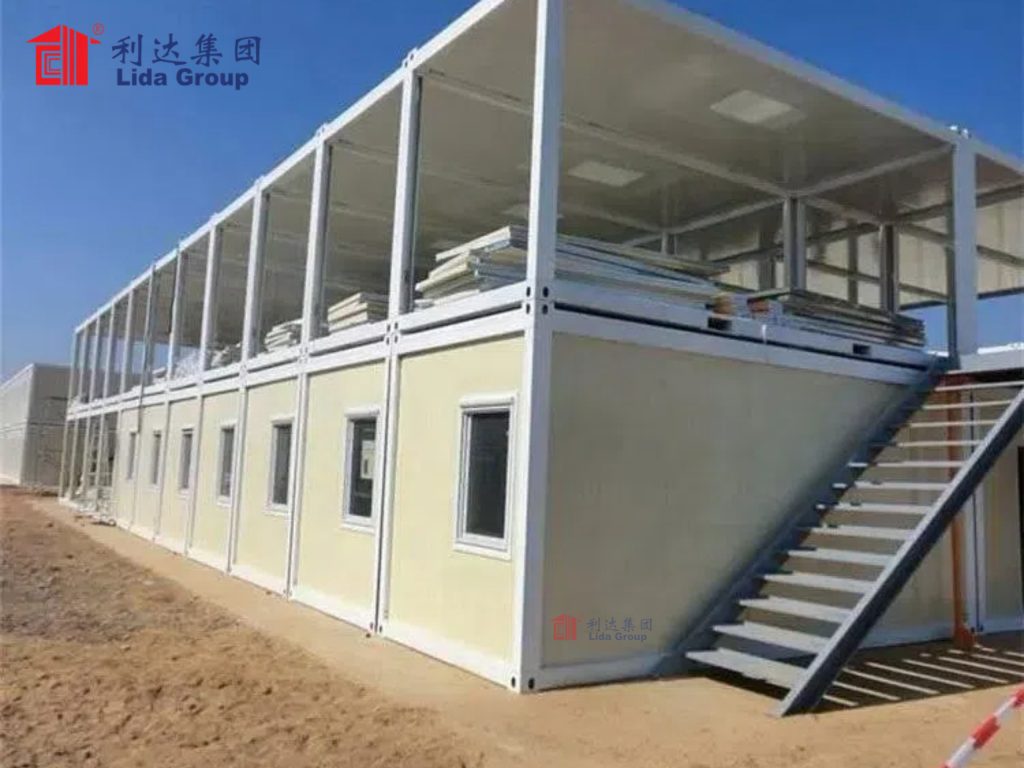
4. Design Features for Typhoon Resilience and Worker Comfort
4.1. Modular Layout for Safety and Functionality
Lida Group’s container dormitories are designed with modular layouts that balance safety and livability:
- Compact Footprint: Containers are arranged in low-rise configurations (typically 1-3 stories) to reduce wind exposure. Clustering containers in small groups (4-6 units) with shared walls increases structural stability compared to isolated units.
- Internal Reinforcements: Interior walls are reinforced with steel studs to maintain structural integrity even if exterior walls are damaged. This creates safe “storm rooms” within the dormitory where workers can seek shelter during the worst of the typhoon.
- Emergency Access: Corridors and doorways are designed to remain accessible even during high winds, with clear pathways to designated safe areas. Exits are marked with high-visibility signage and emergency lighting (battery-powered to withstand power outages).
4.2. Utility Systems for Typhoon Conditions
Typhoons often cause power outages and disrupt water supplies, so Lida Group integrates resilient utility systems:
- Backup Power: Each dormitory complex includes diesel generators (housed in reinforced enclosures) or solar-battery systems to provide power during outages. These systems are designed to start automatically when grid power fails.
- Water Storage and Filtration: Potable water is stored in sealed, elevated tanks (protected from debris) to ensure supply during flooding. Water filtration systems are included to treat rainwater or contaminated water if needed.
- Storm-Resistant Electrical Systems: Wiring and electrical panels are mounted at least 1.5 meters above floor level to avoid flood damage. Circuits include surge protectors to guard against lightning strikes.
4.3. Comfort Features for Coastal Environments
While safety is paramount, Lida Group’s dormitories also prioritize worker comfort in harsh coastal conditions:
- Insulation: Containers are insulated with high-performance materials (e.g., polyurethane foam) to regulate temperature, keeping interiors cool in tropical climates and warm during cooler seasons.
- Ventilation: Natural ventilation is enhanced through strategically placed windows and vents, while air conditioning systems (with backup power) provide relief from high humidity.
- Corrosion Resistance: All metal components (frames, fasteners, fixtures) are treated with anti-corrosion coatings to withstand salt spray, a common issue in coastal areas. This extends the dormitory’s lifespan and reduces maintenance needs.
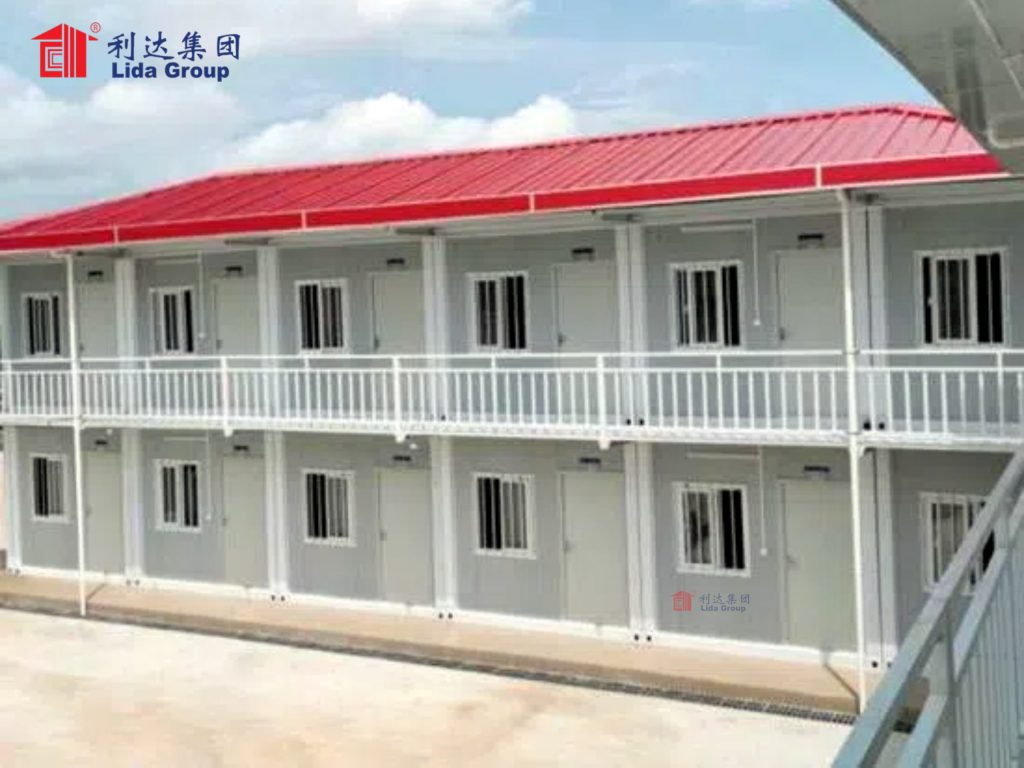
5. Benefits of Lida Group’s Typhoon-Resistant Container Dormitories
5.1. Enhanced Worker Safety
The primary benefit is the protection of workers during typhoons. The reinforced structures have been tested to withstand winds of up to 250 km/h and storm surges of up to 3 meters, significantly reducing the risk of injury or death. In post-typhoon assessments, Lida Group’s dormitories have consistently remained intact, even when nearby traditional housing was destroyed.
This safety record not only protects lives but also reduces liability for project operators, who face increasing pressure to ensure worker welfare in high-risk environments.
5.2. Reduced Downtime and Costs
Typhoon-resistant dormitories minimize operational disruptions. Unlike traditional housing, which may require extensive repairs or replacement after a storm, Lida Group’s containers typically sustain only minor damage (e.g., dented cladding, damaged gutters), allowing for quick repairs and a rapid return to operation.
For example, a coastal construction project in the Philippines using Lida Group’s dormitories resumed operations within 48 hours of a Category 4 typhoon, while a neighboring project with traditional housing was delayed for six weeks. The cost savings from reduced downtime often outweigh the initial investment in typhoon-resistant features.
5.3. Durability and Longevity
The reinforced construction and corrosion-resistant materials used in Lida Group’s dormitories ensure a long service life (15-20 years) in harsh coastal environments. This reduces the need for frequent replacement, lowering long-term costs and minimizing waste.
In regions with frequent typhoons, the durability of these structures provides a reliable housing solution that can withstand repeated exposure to extreme weather, making them a cost-effective choice over time.
5.4. Compliance with Coastal Building Standards
Lida Group’s container dormitories are designed to meet or exceed international and regional standards for typhoon resistance, including:
- ASCE 7 (USA): Minimum design loads for buildings and other structures, including wind loads for coastal regions.
- BS EN 1991-1-4 (EU): Eurocode for wind actions on structures.
- Local Standards: Compliance with regional codes, such as the Philippines’ National Structural Code or Japan’s Building Standard Law, which include specific provisions for typhoon and earthquake resistance.
This compliance simplifies permitting and ensures that projects meet regulatory requirements for worker safety in high-risk areas.
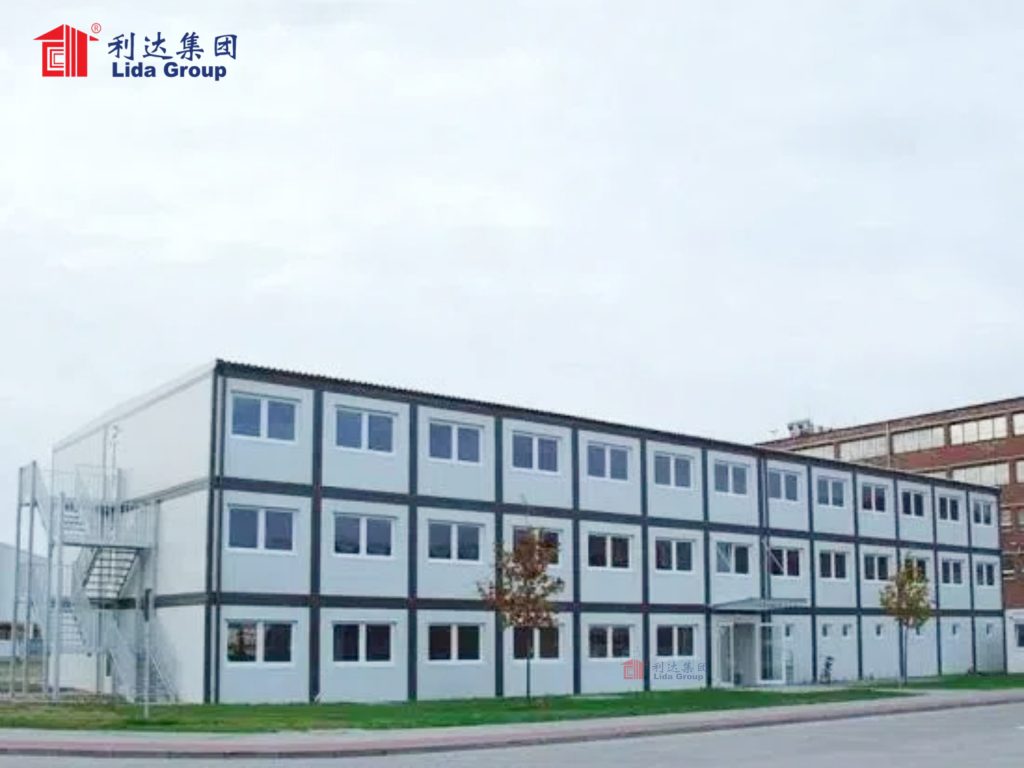
6. Real-World Applications: Typhoon-Resistant Dormitories in Action
6.1. Port Expansion Project in the Philippines
A major port expansion project in the Philippines, located in a region hit by 3-5 typhoons annually, required accommodation for 200 workers. Lida Group supplied 50 reinforced container dormitories, anchored to concrete pile foundations and elevated 1.5 meters above ground.
In 2023, the project was directly hit by a Category 4 typhoon with sustained winds of 215 km/h and a 2-meter storm surge. Post-storm inspections found that the dormitories remained structurally intact, with only minor damage to exterior cladding. Workers sheltered safely in the dormitories during the storm, and no injuries were reported. The dormitories were operational within three days, allowing the project to resume quickly. In contrast, nearby temporary housing for local workers was destroyed, highlighting the superiority of Lida Group’s design.
6.2. Offshore Wind Farm Construction in Taiwan
A wind farm developer in Taiwan needed to house 150 technicians during the construction of offshore turbines. The project site, on the island’s western coast, is exposed to frequent typhoons and strong monsoon winds.
Lida Group’s container dormitories were installed on elevated steel platforms, with reinforced roofs and impact-resistant windows. In 2022, the site experienced a typhoon with winds of 185 km/h, which caused minor damage to the dormitories’ gutters but left the structures and foundations undamaged. The backup generator system ensured power was maintained throughout the storm, and waterproofing prevented any water intrusion. Workers praised the comfort and safety of the dormitories, noting that the reinforced structure minimized noise from high winds.
6.3. Coastal Road Construction in Vietnam
A coastal road project in central Vietnam required housing for 100 workers in an area prone to both typhoons and flash flooding. Lida Group’s solution included 25 container dormitories with concrete slab foundations, waterproofing, and elevated floors.
In 2021, the region was hit by a typhoon that brought 170 km/h winds and 300 mm of rain in 24 hours. The dormitories withstood the winds without structural damage, and their waterproofing systems prevented floodwater from entering, even as surrounding areas were submerged. The drainage system around the dormitories directed water away from the structures, protecting the foundations. The project was able to resume work within a week, with no loss of accommodation capacity.
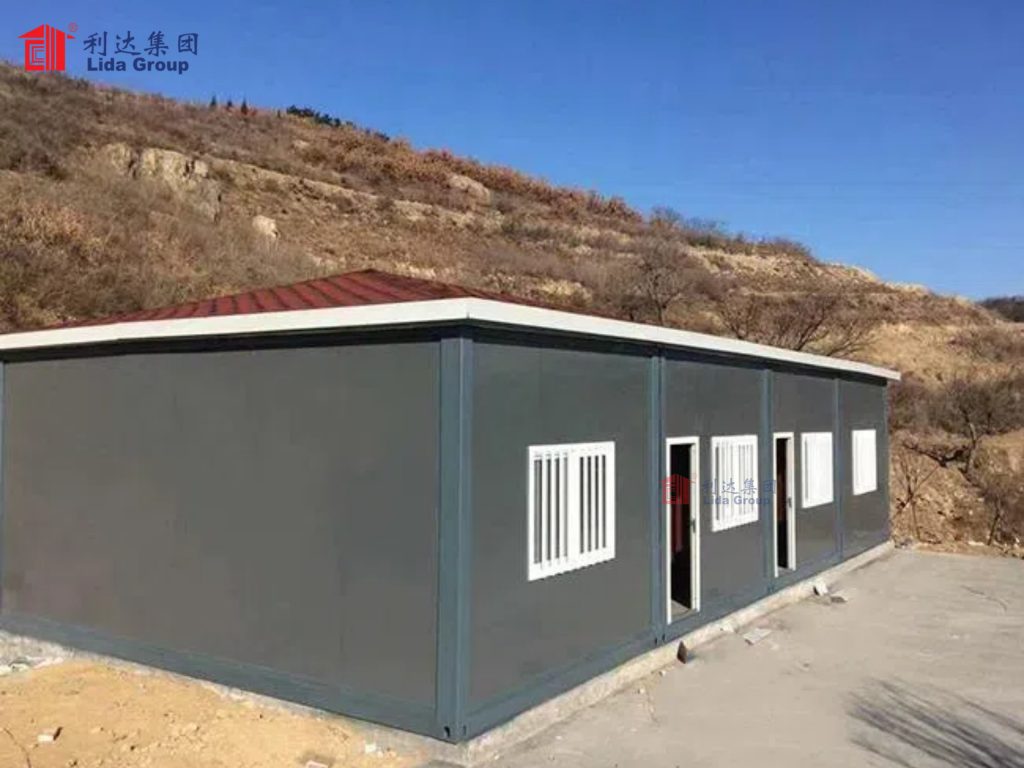
7. Challenges and Solutions in Implementing Typhoon-Resistant Dormitories
7.1. Balancing Cost and Resistance
Reinforced typhoon-resistant features can increase upfront costs compared to standard container housing. Lida Group addresses this by:
- Modular Reinforcements: Offering tiered levels of reinforcement (e.g., basic for areas with occasional typhoons, advanced for high-risk zones) to match project budgets with risk levels.
- Long-Term Cost Analysis: Providing clients with data showing that reduced repair costs, downtime, and insurance premiums offset higher initial investments within 2-3 years.
- Bulk Order Discounts: For large projects, offering discounts on reinforced components, making typhoon resistance more affordable.
7.2. Transportation and Installation in Remote Coastal Areas
Coastal construction sites are often remote, with limited access, making it challenging to transport heavy reinforced containers and install specialized foundations. Solutions include:
- Local Manufacturing: Establishing regional production facilities to reduce transportation distances and costs.
- Lightweight Reinforcements: Using high-strength but lightweight materials (e.g., advanced steel alloys) to reduce container weight without compromising strength.
- Mobile Installation Teams: Deploying specialized teams with portable equipment (e.g., pile drivers, cranes) to install foundations and containers in remote areas.
7.3. Maintenance in Saltwater Environments
Salt spray and humidity in coastal areas can accelerate corrosion, even with protective coatings. Lida Group recommends:
- Regular Inspections: Scheduled checks (quarterly in high-salt areas) to identify and repair corrosion, loose fasteners, or damaged waterproofing.
- Protective Coatings: Applying marine-grade anti-corrosion coatings every 2-3 years to extend component life.
- Stainless Steel Components: Using stainless steel for critical fasteners and hardware to resist corrosion.
7.4. Adapting to Evolving Typhoon Patterns
Climate change is leading to more intense and frequent typhoons, requiring structures to meet higher resistance standards. Lida Group stays ahead by:
- Continuous Testing: Conducting ongoing wind tunnel and structural tests to develop stronger, more resilient designs.
- Upgradable Features: Designing dormitories with modular reinforcement components that can be upgraded as risk levels increase.
- Climate Data Integration: Using regional climate models to tailor designs to projected future typhoon intensity in specific coastal areas.
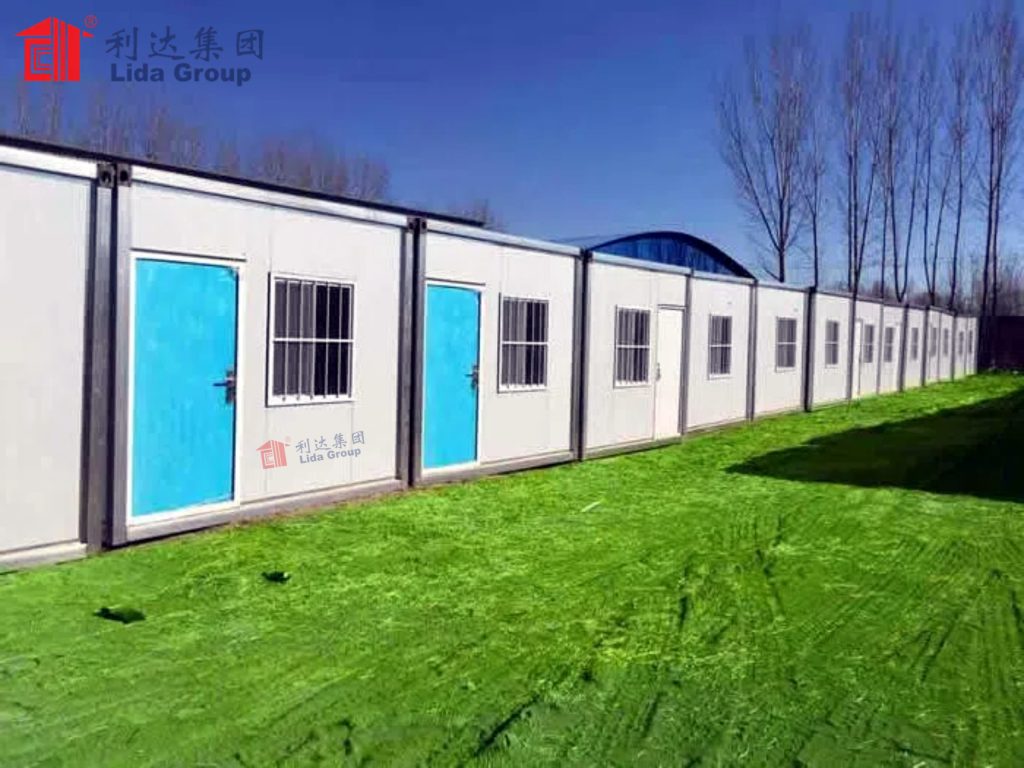
8. Future Trends in Typhoon-Resistant Prefab Housing
8.1. Advanced Materials for Enhanced Resistance
Future container dormitories will incorporate cutting-edge materials to improve typhoon resistance:
- Carbon Fiber Reinforcements: Lightweight carbon fiber composites will strengthen steel frames, increasing resistance to wind pressure while reducing weight.
- Self-Healing Coatings: Smart coatings that automatically repair small cracks or scratches, maintaining waterproofing and corrosion resistance.
- Impact-Absorbing Panels: Exterior panels made from energy-absorbing materials that reduce damage from flying debris.
8.2. Smart Monitoring and Early Warning Systems
Integration of IoT (Internet of Things) technology will enhance safety:
- Wind and Pressure Sensors: Real-time sensors will monitor wind speeds and structural stress, alerting managers to potential issues during storms.
- Early Warning Integration: Dormitories will connect to regional typhoon warning systems, automatically triggering safety protocols (e.g., closing storm shutters, activating backup power) when a typhoon approaches.
- Remote Structural Health Monitoring: Cloud-based systems will allow engineers to monitor the integrity of dormitories from afar, identifying maintenance needs before they become critical.
8.3. Sustainable and Resilient Designs
Future typhoon-resistant dormitories will combine resilience with sustainability:
- Solar Integration: Reinforced roofs will include solar panels to generate renewable energy, reducing reliance on diesel generators during power outages.
- Rainwater Harvesting: Enhanced drainage systems will collect and store rainwater for non-potable use, improving water security during storms.
- Recyclable Materials: Increased use of recycled and recyclable steel and composites, reducing environmental impact without compromising strength.
8.4. Community-Focused Design
In regions where worker dormitories double as emergency shelters for local communities during typhoons, Lida Group is developing designs with:
- Increased Capacity: Modular expansions that allow dormitories to house additional people during emergencies.
- Emergency Supplies Storage: Built-in storage for food, water, and medical supplies, making dormitories self-sufficient during post-typhoon recovery.
- Accessibility Features: Ramps, widened doorways, and emergency facilities to accommodate people with disabilities during evac
uations.
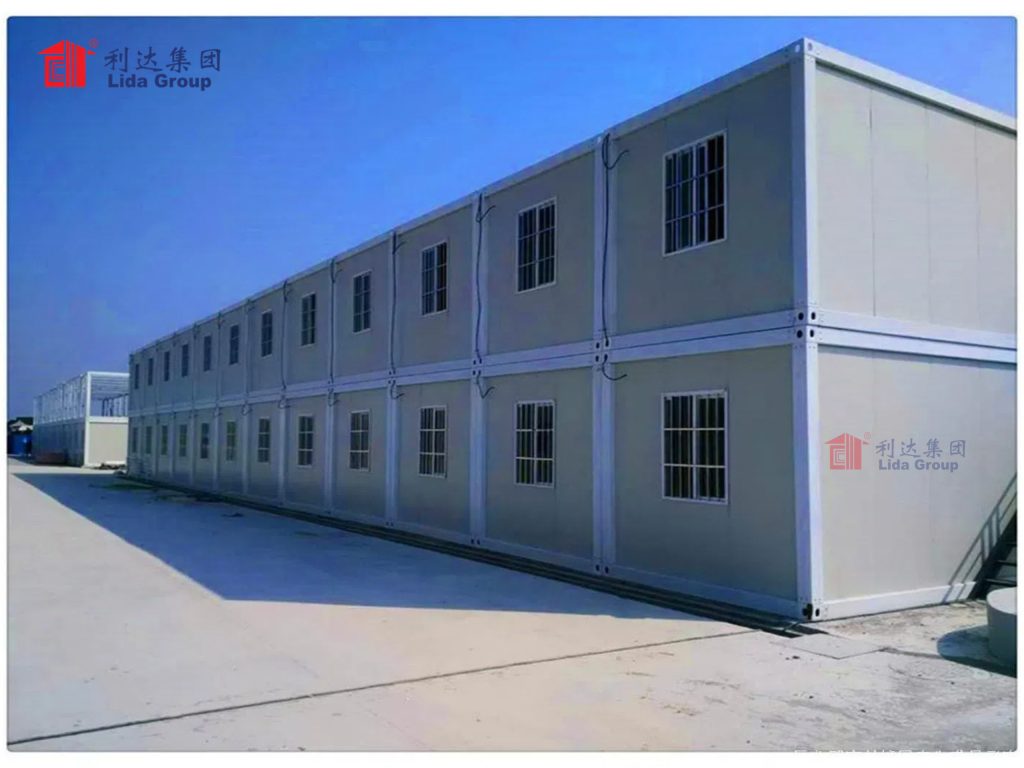
9. Conclusion
Lida Group’s typhoon-resistant container worker dormitories represent a critical innovation in ensuring safety and operational continuity for coastal industrial projects. By integrating reinforced prefab building structures with specialized design features, these dormitories address the unique threats posed by typhoons—high winds, storm surges, and flooding—while maintaining comfort and functionality for workers.The structural reinforcements, from high-strength steel frames and impact-resistant cladding to secure foundation systems, enable these dormitories to withstand winds up to 250 km/h and storm surges of 3 meters, far exceeding the resilience of traditional temporary housing. Waterproofing, elevated platforms, and robust utility systems further protect against flooding and power outages, ensuring habitability even in the aftermath of severe storms.Real-world applications in the Philippines, Taiwan, and Vietnam demonstrate the practical effectiveness of these designs, with projects resuming quickly after typhoons while neighboring accommodations suffered extensive damage. The benefits extend beyond safety, including reduced downtime, lower long-term costs, and compliance with strict coastal building standards—factors that directly contribute to project success in typhoon-prone regions.Challenges such as cost, remote installation, and corrosion are met with innovative solutions, from tiered reinforcement options to local manufacturing and smart maintenance protocols. Looking ahead, advancements in materials, IoT monitoring, sustainable integration, and community-focused design will further enhance the resilience and versatility of these dormitories.In an era of increasingly intense typhoons due to climate change, Lida Group’s typhoon-resistant container dormitories set a new standard for worker accommodation in coastal areas. They prove that safety, durability, and sustainability can coexist, providing a reliable foundation for industrial development while protecting the lives of workers and, in many cases, local communities. As coastal projects continue to expand, these structures will play a vital role in ensuring resilience, efficiency, and responsibility in high-risk environments.

Related news
-
Vertical Camp Innovation: Multi-Story Container Worker Dormitories Maximize Space via Lida Group's Prefab Building Engineering
2025-08-21 17:43:51
-
Secure Workforce Solutions: Lida Group's Container Worker Dormitories Incorporate Access Control in Prefab Building Designs
2025-08-21 15:22:24
-
Sustainable Labor Camps: Lida Group's High-Quality Container Houses Reduce Carbon Footprint 35% with Solar-Ready Prefab Roofs
2025-08-22 13:36:15
contact us
- Tel: +86-532-88966982
- Whatsapp: +86-13793209022
- E-mail: sales@lidajituan.com


